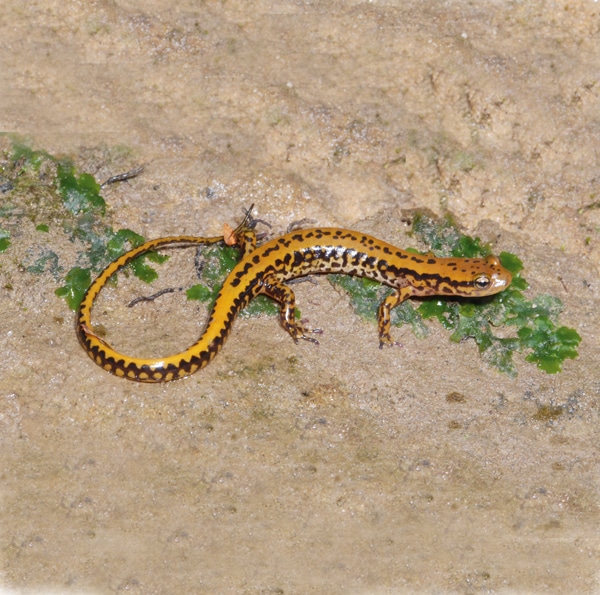I love to seek herps out in their natural haunts, so when Reptiles USA asked me to write about my favorite 20 herping spots, it was a challenge to whi
I love to seek herps out in their natural haunts, so when Reptiles USA asked me to write about my favorite 20 herping spots, it was a challenge to whittle my choices down to so few. Fieldherping was my most impassioned pursuit as a boy during the warm months growing up in east-central New Jersey. Not much has changed since those cherished days of childhood, except that back then, the goal was to capture them to keep for the summer. I still love to go out every chance I get, but now it’s 99 percent just to photograph them.
Read More
5 Great Costa Rican Herping Destinations
New Jersey
The herping pleasures of my childhood were spent pursuing snakes, turtles and frogs in the many ponds near my home in Middlesex County in New Jersey. Sneaking up on painted and spotted turtles, and garter and water snakes, took patience and stealth—traits requiring practice for most children. Catching them (sometimes, anyway), and bringing them home as temporary pets over summer, taught me valuable early lessons about fieldherping and husbandry. Those reminiscences marked the path my life would follow to this day. I feel so sorry for city-bound young people today, who grow up without easy access to nature, or whose parents and mentors teach them to fear nature instead of encouraging them to experience wild herps in person.
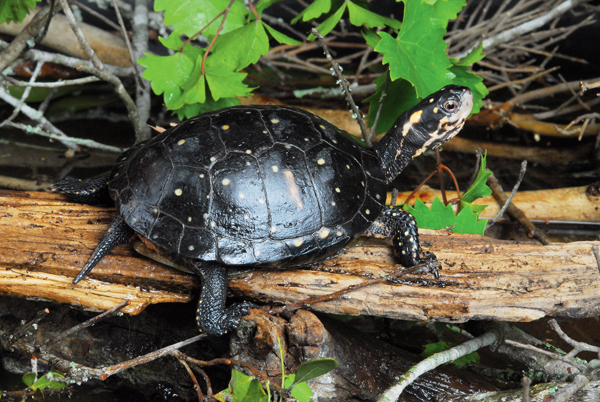
bill love
Spotted turtles (Clemmys guttata) are typically among the first baskers to emerge from hibernation during spring in New Jersey’s wetlands.
Florida Everglades
I lived at the edge of the Everglades for four decades, so they became a frequent destination for fieldherping. The vastness of the Glades is bisected by two main east-west roads—Alligator Alley (State Road 84, and now part of Interstate 75) and the Tamiami Trail (State Road 41)—and crossed by one other smaller one, State Road 9336, a two-lane road down to Flamingo at the southern end of Everglades National Park (ENP). Back in the good ol’ days, all of these were “road-cruisable” for snakes. Nowadays, heavy traffic on the first two highways precludes any hope of doing that safely or legally. These roads take a daily toll of all wildlife attempting to cross, especially snakes and turtles. This sad situation isn’t going to change anytime soon, but it’s a clue as to how many herps can be seen by exploring the fringe zones near those same roads. Walking along canal banks can yield sightings of numerous water snakes and racers.
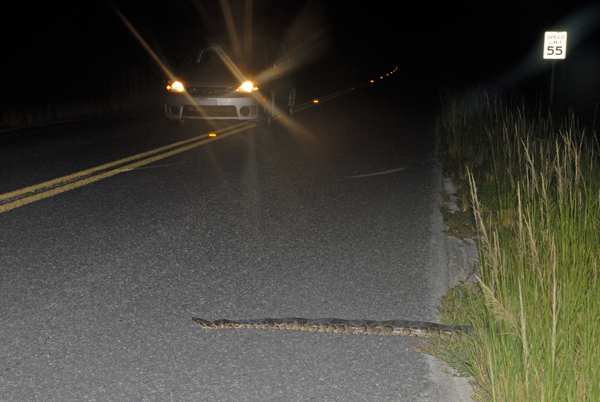
bill love
A Burmese python (Python molurus bivittatus) crossing the road through Everglades National Park on a summer night.
SR 9336 is exceptional in that you can drive it at night during the warm months and see numerous common herps, such as mud turtles, corn snakes, yellow rats, kingsnakes, several species of water snakes, ribbon snakes, scarlet snakes, eastern diamondbacks and, for the last decade or so, Burmese pythons. All wildlife inside ENP is protected from collection, but it’s perfectly fine to look for all manner of herps on this smooth, paved road for photography purposes. Just be sure to pull completely off the road surface if you stop. Watch out for water moccasins—a very abundant resident of ENP—in tall grass if you park off the pavement. The odds of stepping on one even there are infinitesimally small, but not out of the realm of possibility.
What you should be even more aware of is another “threat” lurking in the grass—insatiable hordes of the thirstiest mosquitoes you’ll likely ever encounter. Go prepared for the onslaught with repellent after sundown or you probably won’t stay long. “Skeeters” are at their worst starting a few days after the first heavy rains of the year (usually in June or July), which happens to also be the best time to seek herps there. At least rest assured the traffic will be almost non-existent after dark, especially on Monday through Thursday evenings. Few people are brave (or crazy) enough to challenge the Glades during the wet season and relinquish the marsh to what many refer to as swarms of the “Florida State Bird.”
Florida, The Keys
Dozens of small- to moderate-sized islands are all connected by U.S. Highway 1, stretching about 160 miles from the mainland below Miami to Key West. They’re the most subtropical portion of Florida, but they have historically had a depauperate native herpetofauna. A race of corn snake, still called “rosy rat” by old-timers, has managed to survive on nearly all of them in a smaller, lighter-colored form. A slightly divergent southern race of yellow rat snake inhabits the upper keys, and Keys races of black racers and ring-neck snakes lower down the chain. A hypomelanistic form of striped mud turtle ekes out an existence where fresh water is present. But many species have never made it that far south, such as kingsnakes, pine snakes and most freshwater turtles.
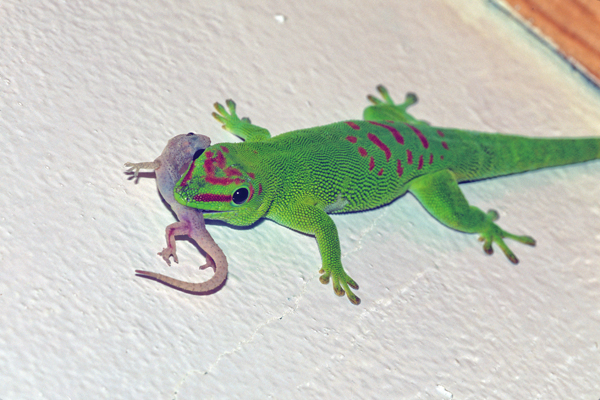
bill love
Madagascar day gecko making a meal of a small house gecko.
The low variety of native herplife is quickly being compensated for with growing numbers of exotic lizards that have been gaining footholds there. Giant day geckos from Madagascar are the biggest and brightest of a half-dozen or more alien geckos. The rosy rat snakes are amazingly still common on many keys, too, surviving in reduced size even on tiny, mostly urbanized Key West.
Florida, The “Sweet Lands”
Citrus groves and sugar cane plantations dominate huge tracts of the lower Florida peninsula’s flat country. To keep the land drained and less prone to flooding, thousands of man-made waterways bisect the landscape between row after row of crops and trees spaced a tractor’s width apart. In the early 1970s, during a first visit to an orange grove that was never originally intended as a herping expedition, I happened upon two huge indigo snakes. I also noted that big agricultural areas like that orange grove happened to spawn huge numbers of rodents and rabbits. Every winter and spring, when the fruit and cane is ripe, incalculable tons are eaten by rodents that shelter along those ditches and canals in holes of the trees and bushes covering them.
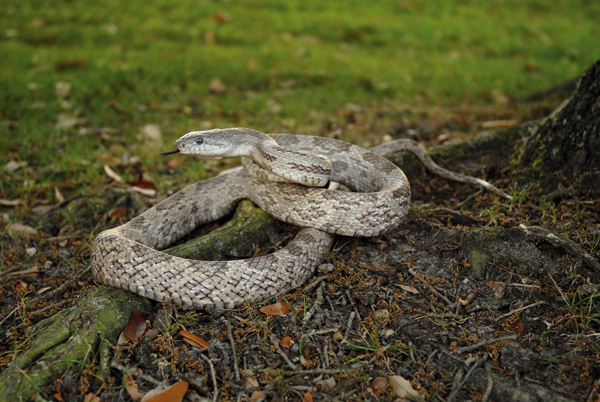
bill love
Grey rat snakes (Elaphe obsoleta spiloides) occur at the peak of their silvery beauty in the Florida Panhandle.
In the lower east coast groves, it wasn’t long before I noticed that Florida’s two rat snakes—corns and yellow rats—were equally, if not even more, abundant there than indigos. Those species made heavy use of the arboreal haunts, specifically the rows of introduced Australian pines and native cabbage palm and oak trees bordering them on every side.
Those able climbers also found the roofs of old pump sheds, abandoned houses and farm shacks much to their liking. The keeled peaks of corrugated metal were particularly attractive places to hide and bask safely. Friends and I learned to seek them there, enticing them out via “noodling” with slender sticks or stiff wire. Noodling works by “tickling” a snake and urging it to move out of the tight place it’s crammed into, like a gap in metal roofing or a small hole in an old concrete block wall. Hopefully, it tries to escape the annoying poking by “coming out to fight” instead of squeezing itself even further, where it cannot be extracted at all.
In the sugar cane fields below Lake Okeechobee, yellow and Everglades rats packed themselves into the wooden or block walls of any structure rising above ground level. Florida kingsnakes prowled the ditch banks in incredible abundance. Walking along the edges of grass-covered ditches, sometimes no wider than a few feet, often yielded husky 4-to 5-foot-long beauties, sunning themselves in the mornings. February and March were the best two months to find them like that, when winter knocked down the luxuriant grass and weeds to make spotting basking kings an easier task.
Florida Panhandle
The northernmost leg of Florida is considered “Florgia” to some because it is up against Georgia, a colloquialism describing the culture and the herpetofauna quite accurately. The vast Apalachicola National Forest occupying the center of the panhandle is crisscrossed by hundreds of miles of dirt logging roads, traversing all habitats from high, dry pine to the low swamplands of Tate’s Hell State Forest.
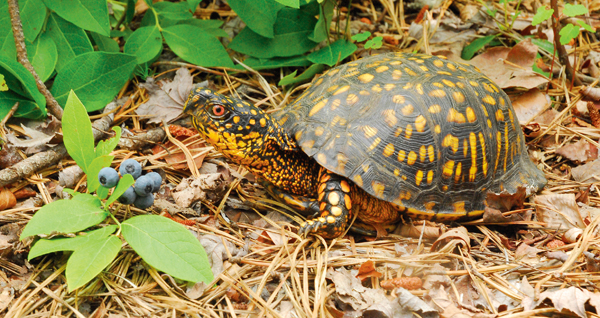
bill love
Gorgeous eastern box turtles (Terrapene c. carolina) and ripe blueberries are two of the best encounters of summer in the New Jersey Pine Barrens.
Innumerable hours spent cruising those endless tracts have been rewarded with a variety of herps unequaled even in the peninsula. Many species reach the northern and southern zeniths of their ranges in this transition zone. Big, black Gulf Coast box turtles (Terrapene carolina major) often amble across those sandy roads. The prettiest silver-gray rat snakes come from there too, but the crown jewel has always been the kingsnake morph of the region—a distinctive-looking creature known as the blotched or Goin’s kingsnake (Lampropeltis getula meansi).
Reelfoot Lake, Tennessee
A volcanic eruption in 1812 caused a bend of the Mississippi River to be cut off and transformed into this swampy lake, creating a virtual paradise for turtles. Nowhere I’ve ever herped offered the abundance of aquatic turtles I’ve seen there! Rent a small motorboat, or just pull up to any place between the cypress trees bordering the shoreline, to see chelonians basking, sometimes two-deep, on nearly every log or limb in the water.
Southern painted turtles (Chrysemys picta dorsalis), map turtles (Graptemys kohnii and G. pseudogeographica), and red-eared sliders (Trachemys scripta elegans) are the dominate species in the vast body of water. Many allow you to get relatively close due to long exposure to fishermen passing nearby in small boats. Local people have fanciful names for the three common types mentioned above—lady turtles, hagglebacks and streakynecks, respectively.
Smoky Mountains
Gurgling streams flowing over rocky beds throughout the forests are home to the largest diversity of salamanders anywhere on Earth. Find them by gently lifting flat stones near or in the water to reveal a wonderful assortment of forms and colors. Rolling moist logs also works. Be careful to replace their hiding places as they were found so they continue to harbor these delicate herps. Two-lined salamanders (Eurycea bislineata), cave salamanders (Eurycea lucifuga) and slimy salamanders (Plethodon glutinosus) are ultra-abundant. Colorful rarities, like the Yonahlossee salamander (Plethodon yonahlossee) and members of the Appalachian woodland (Plethodon jordani) complex are not too difficult to find with some diligence.
New Jersey Pine Barrens
I didn’t get to seriously herp this alcove of nature in the southern half of the state until long after I moved from N.J. to Florida. But subsequent visits have allowed me to see many beautiful herps, some of which reach the northern limits of their ranges here such as Pine Barrens tree frogs, and chain kingsnakes, corn snakes and pine snakes. Eastern box turtles are still sighted on back roads, especially after summer rains. If you go in midsummer or later, a bonus to walking for herps is munching wild blueberries. The down side is ticks, but these can be largely deterred with proper avoidance measures, like applying a heavy saturation of spray repellent to your socks and lower pants legs, and staying on open paths (when possible) that help you avoid brushing against tall grass and weeds, where hungry ticks await the chance to cling onto their next hosts.
The "Tin Fields"
These are not specific places, but rather a broad descriptive term to encompass the art and fun of flipping old tin blown from crumbling houses and barns in the more countrified parts of the lower east coast of the U.S. The two Carolinas and Georgia are most renowned for them, but old tin can produce results anywhere. Old sheets of the rusting, corrugated stuff (and other debris, such as plywood, car hoods, etc.) become havens for all kinds of snakes. This is particularly true on sunny spring days following chilly nights when they like to shelter under it to warm up while still hidden from view.
Southern Georgia
For sheer volume of snake sightings, it’s hard to beat rural areas dotted with abandoned buildings and dump piles of trash. These “reservoirs” of discarded refuse sometimes harbor large numbers of rat, king and rattlesnakes during certain times of the year. Not much tops the excitement of lifting a long piece of tin to the sound of a canebrake’s buzzing tail. Southern Georgia contains a great deal of opportunities for canebrake rattlesnake sightings, among many other herps.
Eastern North Carolina
I spent one of the most enjoyable four-day expeditions of my life bicycling around this sparsely populated region looking for herps on and near the road. My companions and I found more box, snapping and mud turtles than we could count, and red pigmy rattlesnakes seen numbered more than 20. I’d seldom peddle more than a few minutes before once again stopping to photograph herps right on the roads or in nearby fields.
Arizona Desert
Arizona’s Sonoran Desert became a blip on my radar back in high school after reading a chapter of Snakes and Snake Hunting by Carl Kauffeld titled “The Ajo Road.” After absorbing every detail of that epic section, I knew that I one day had to cruise that road myself. My first chance came a few years later in July of 1974. It was at the beginning of the summer monsoon (rainy) season, and I was not disappointed by the quantity or variety of what I found gracing the pavement.
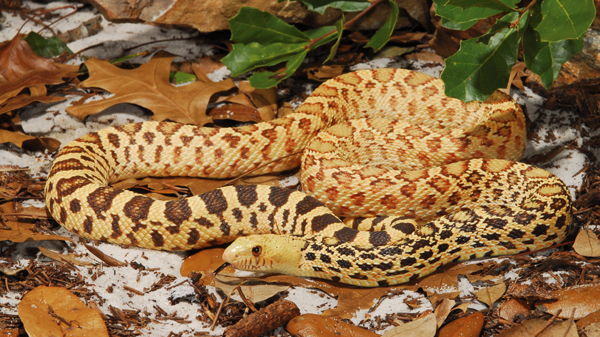
bill love
A variety of gopher snakes can be found in the Sonoran Desert.
Western diamondbacks (Crotalus atrox), Mojave rattlesnakes (C. scutulatus) and numerous sidewinders (C. cerastes) were almost ridiculously abundant, and long-nosed snakes (Rhinocheilus lecontei), Sonoran gophers (Pituophis catenifer affinis), glossy snakes (Arizona elegans) and a variety of dinky desert-dwelling specialists, such as sand snakes (genus Chionactis), shovelnose snakes (Chilomeniscus stramineus) and leaf-nosed snakes (genus Phyllorhynchus) rounded out a typical night’s foray.
The approximately six-week period from mid-July through August is generally considered the best time to herp the deserts. Deprived of water for a half year by then, herps are eager to move when water is suddenly abundant and desiccation isn’t such a concern. It’s hot by then, so many species become nocturnal to avoid the extreme daytime temps. Slowly driving roads less-traveled often pays off big time, especially if you start an hour before sunset. Don’t wait until the sun fully sets until you head out; the main thrust of crepuscular herp activity begins before dusk.
Arizona Sky Islands
Deserts aren’t the only delights in Arizona. Approximately 21 scattered mountain ranges spread across the southern third of the state offer a contrastingly distinct variation in habitat and resident herpetofauna. There are many more mountains than that, but only these few reach elevations, with moister peaks harboring isolated species that are more characteristic of Mexico further to the south.
I first read about one Sky Island range in particular—the Huachucas—in, again, Carl Kauffeld’s book, Snakes and Snake Hunting. The allure of seeing some of the USA’s most beautiful little rattlesnakes in ruggedly forested mountains alone would be enough of a draw, but the added possibilities of beautiful black-and-yellow blacktail rattlesnakes, Arizona mountain kingsnakes (Lampropeltis pyromelana) and Madrean alligator lizards (Gerrhonotus kingii) makes these isolated peaks a must-experience for all dedicated fieldherpers.
Southern Texas
Texas spans so much territory that to list simply “Texas” as a great herping destination doesn’t whittle it down enough to be useful information. But to narrow it down to the mesquite prairies of the southern horn is relaying sound advice. That still leaves thousands of miles of habitat, but finding a quiet country road traversing this seemingly endless cattle country is likely to provide an interesting assortment of herps by road cruising it for the several hours of dusk and early evening.
My times down there have mirrored most others in noting that western diamondback rattlesnakes are the hands-down most common find. They appear often, typically several per night while road-cruising, in the 3- to 3½-foot-long size range. But 5- to 6-footers still show up infrequently enough to remind you how thick they can get. Unfortunately, the search for oil has brought heavy truck traffic to southern Texas, making it a challenge to find peaceful back roads, even in remote counties with few people.
West Texas / Big Bend National Park
With a whole lot of Texas beckoning herpers, it’s sometimes hard to nail down which part to visit. The dryer end, often referred to as the “Trans-Pecos,” most often wins out for me. This is the region west of the Pecos River where many essentially Mexican herps enter the U.S. in the northern extents of their ranges. Several of them, like the gray-banded kingsnake (Lampropeltis alterna) and Trans-Pecos rat snake (Bogertophis subocularis), are among the most coveted species in herpetoculture today.
Although beautiful morphs exist for L. alterna and B. subocularis, a dedicated subculture of herpers devote a week each summer to find these and other West Texas specialties in the field. Cruising remote roads from dusk until the wee hours of the morning was the traditional method of choice for finding them until sometime before the turn of the century when a new hunting strategy arose—“shining the cuts.” What the heck does that mean?
When roadways were built across hilly areas, the route was leveled considerably by cutting through the rock, leaving walls flanking the pavement anywhere from several to more than 50 feet high. Those craggy sides are riddled with crevices that snakes find irresistible, and they are easily accessed by herpers. When certain ideal weather conditions prevail, it’s possible to check these cuts by flashlight and spot nocturnal snakes clinging to cracks while exploring for mates, food and shelter.
Southern California
I can hardly recall a finer time than driving the lonely road through Anza-Borrego Sate Park in San Diego County one early October night. I must have passed several neonate sidewinders coiled on the road when my pal asked why I wasn’t interested in looking at them up close. I thought they were pale rocks, not snakes! Tons of banded geckos, glossy snakes and red diamond rattlesnakes were also out in numbers that night to make it one of the most herp-intensive drives of my life.
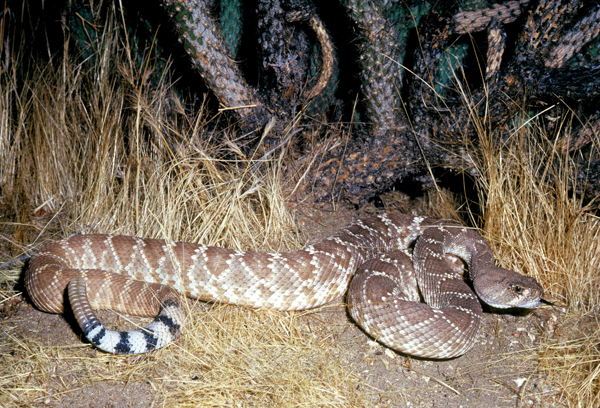
bill love
One of many red diamond rattlesnakes (Crotalus ruber) found in the late 1970s in Anza-Borrego State Park inland of San Diego, Calif..
Mexico
Just south of our southern border is one of the most diverse countries in the world herpetologically. I’ve barely scratched the surface exploring it, but I have already enjoyed several unforgettable herp encounters. Standing out among them was seeing a gorgeous pair of Dickerson’s collared lizards (Crotaphytus dickersoni) in a hilly canyon above Bahia Kino, and later on the same trip coming upon a large Mexican beaded lizard while fieldherping by foot at night on a steep creekside hill near the small town of Alamos. Both towns are in the state of Sonora on the upper west coast.
Nothing but fond memories persist from my four herping visits to Baja. On my last one, I walked roughly 47 kilometers into the mountains above Cabo San Lucas with two local guides who spoke zero English. We camped and also stayed with their extended family living many hours’ walk up a stream from the nearest road in a totally self-sufficient hacienda ranch. I saw numerous Baja blue rock lizards (Petrosaurus thalassinus), one of the most vibrant herps to ever exist.
Amazonian Peru
What herper doesn’t want to see the mighty Amazon River and its unrivaled rain forest? My chance came on a two-week tour in 1996. My group stayed the first week on a floating motel boat, plodding along and making many stops on the upriver course. The second week was spent in a remote lodge that was literally crawling with herps and invertebrates, both in the surrounding forest and inside the rooms. Although more than 100 species of herps were seen, including matamata turtles, fer-de-lance and Amazon tree and red-tail boas, the live black scorpion that sat in my shoe (under my socked toes) for almost an hour during breakfast remains my most cherished recollection—mainly because it did not result in any harm to me.
Every herp enthusiast needs to spend at least a week exploring this last great bastion of wilderness. Many tour companies can help you accomplish that after a short four-hour flight from Miami to Iquitos—a city only reachable by boat or plane. You can’t bring your finds back home with you, but the photos and memories you return with will last a lifetime. Many Amazon Basin anurans are shades of browns, but this little clown frog (Hyla leucophyllata) broke from the mold admirably.
Australia
The other “A” that beckons to all herpers is often called “Oz,” and it, too, is a magical place for the reptile-oriented. Two thirds of the land vertebrates there are herps, and they’re abundant and fairly easily viewable once you escape the coastal cities. The first ones I saw on my first visit in ‘93 were bearded dragons, adorning the tops of fence posts north of Adelaide. They were happy to watch you driving past, but dove for cover the moment your vehicle stopped to admire them.
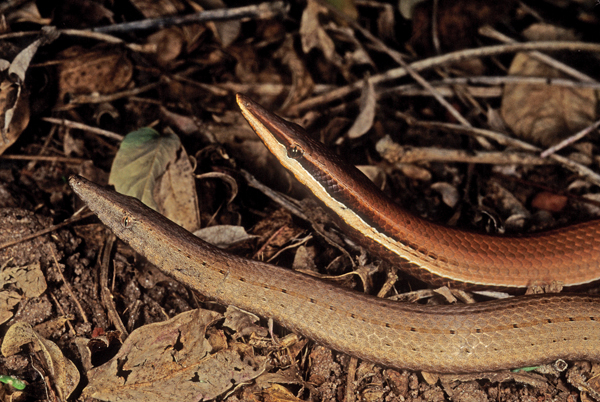
bill love
Burton’s legless lizards (Lialis burtoni) were seen by the dozens one night. They are sexually dimorphic; the female is the lower one.
Road-cruising roads “out in the boonies,” which are most highways in the country, has yielded a plethora of amazing herps for me in Queensland, Western Australia, and the Top End (around Darwin). Slowly driving such quiet routes in the sub-equatorial summertime (December through February) has netted me Stimson’s, olive, Children’s and scrub pythons; Burton’s legless lizards; snake-neck turtles; knob-tail geckos and monitors (called “goannas” in Oz). I’ve walked upon leaf-tailed geckos in isolated patches of rain forest (at night in the rain), and have seen carpet pythons in barn roofs and in seaside rocks where waves crashing against them threw salt spray on my camera.
Madagascar
It’s only appropriate to end the list with my “home away from home”—a place I’ve loved since my first of 12 visits beginning in 1991. The world’s fourth largest island is home to the greatest number of herps of any country of comparable size. The native herps are incredibly common at many venues. You’d have to be blind to miss seeing oodles of colorful chameleons and day geckos at nearly any place you stopped. The three endemic boas—Madagascar tree boa (Sanzinia madagascariensis), ground boa (Acrantophis madagascariensis) and Dumeril’s boa (Acrantophis dumerili)—require a little more effort, but it’s virtually a given that you will see them if you hire Malagasy guides stationed in all the major parks. Even the always-impressive radiated tortoises are accessible in the southwest, but populations continue to dwindle due to various human pressures.
The people of Madagascar are poor but extremely friendly. Children in rural villages are especially eager to help you locate and photograph wildlife. A favorite past time for me when leading ecotours is asking kids to collect large grasshoppers so we can photograph them being popped off our noses by the tongues of big chameleons. I always tip local children for their help, and I also make sure they see the animals walk free after our photo sessions so they come to value the economic stimulus tourism brings to see their extraordinary herpetofauna, which they might not have otherwise appreciated.
Epilogue
It should be noted that times are rapidly changing since my youthful days of fieldherping. Many of my old haunts are now behind barbed wire fences and posted with no trespassing signs. Metal scrappers are collecting much of the old tin that used to abound. Restrictive laws are multiplying faster than rabbits, crushing our ability to catch and even touch many species deemed endangered. Nowadays, I hunt herps predominantly with a camera, so these tales of the chase to catch and keep are stories of yesteryear’s glories.
Advice for modern times: Before you get inspired to follow in my footsteps, be aware that we now live in a more regulated climate, where replicating some of my exploits could land you in hot water. Check with local laws to know what you can do legally so you avoid hassles and legal troubles. Don’t let increasingly heavy-handed Big Brother’s continuing flood of new rules ruin a great day out herping if you can avoid it before it ever happens.
Bill Love photographs herps in nature, writes and lectures. He assists his wife, Kathy, with her business, CornUtopia, and via his company, Blue Chameleon Ventures, leads nature tours to view herps in Madagascar.

